SUMMARY CMI
Keppra® oral solution
Consumer Medicine Information (CMI) summary
The full CMI on the next page has more details. If you are worried about using this medicine, speak to your doctor or pharmacist.
1. Why am I using Keppra®?
Keppra® contains the active ingredient levetiracetam. Keppra® is used to control epilepsy.
For more information, see Section 1. Why am I using Keppra®? in the full CMI.
2. What should I know before I use Keppra®?
Do not use if you have ever had an allergic reaction to levetiracetam or any of the ingredients listed at the end of the CMI.
Talk to your doctor if you have any other medical conditions, take any other medicines, or are pregnant or plan to become pregnant or are breastfeeding.
For more information, see Section 2. What should I know before I use Keppra®? in the full CMI.
3. What if I am taking other medicines?
Some medicines may interfere with Keppra® and affect how it works.
A list of these medicines is in Section 3. What if I am taking other medicines? in the full CMI.
4. How do I use Keppra®?
- Keppra® Oral Solution should be taken twice a day at the prescribed amount by your doctor.
- Use the syringe provided in the cardboard box to measure the exact quantity of oral solution.
More instructions can be found in Section 4. How do I use Keppra®? in the full CMI.
5. What should I know while using Keppra®?
| Things you should do |
|
| Things you should not do |
|
| Driving or using machines |
|
| Drinking alcohol |
|
| Looking after your medicine |
|
For more information, see Section 5. What should I know while using Keppra®? in the full CMI.
6. Are there any side effects?
Common potential side effects: dizziness, forgetfulness, loss of concentration, headaches, rash, itchy and dry skin, headache, common cold, upset stomach, diarrhoea, blurred vision, muscle pain, feeling tired, drowsy or sleepy and feeling weak. Serious potential side effects: feelings of depression, mood changes such as depression, nervousness, aggression, anger, anxiety, confusion, hallucination, irritability, more frequent or more severe seizures, allergic reactions (shortness of breath, wheezing or difficulty breathing, swelling of the face, lips, tongue or other parts of the body, rash, itching or hives on the skin) and a combination of flu-like symptoms with widespread skin rash and/or high temperatures. For more information, including what to do if you have any side effects, see Section 6. Are there any side effects? in the full CMI.
FULL CMI
Keppra® oral solution (pronounced “KEPP-ruh”)
Active ingredient: levetiracetam (pronounced "LEE ve tye RA se tam")
Consumer Medicine Information (CMI)
This leaflet provides important information about using Keppra®. You should also speak to your doctor or pharmacist if you would like further information or if you have any concerns or questions about using Keppra®.
Where to find information in this leaflet:
1. Why am I using Keppra®?
2. What should I know before I use Keppra®?
3. What if I am taking other medicines?
4. How do I use Keppra®?
5. What should I know while using Keppra®?
6. Are there any side effects?
7. Product details
1. Why am I using Keppra®?
Keppra® contains the active ingredient levetiracetam. Keppra® is an antiepileptic drug.
Keppra® is used to control epilepsy. Epilepsy is a condition where you have repeated seizures. There are many different types of seizures, ranging from mild to severe.
2. What should I know before I use Keppra®?
Warnings
Do not use Keppra® if:
- you are allergic to levetiracetam, or any of the ingredients listed at the end of this leaflet.
- Always check the ingredients to make sure you can use this medicine. Keppra® oral solution contains maltitol. Do not use this medicine if you have hereditary problems of fructose intolerance.
Check with your doctor if you:
- have any other medical conditions such as kidney or/and liver problems,
- allergic reactions to any medicines, especially barbiturates (such as phenobarbitone) or any other antiepileptic medicines (such as carbamazepine, lamotrigine or levetiracetam) or any other substances, such as foods, preservatives or dyes.
- and any other mental health condition, such as depression.
During treatment, you may be at risk of developing certain side effects. It is important you understand these risks and how to monitor for them. See additional information under Section 6. Are there any side effects?
Pregnancy and breastfeeding
Check with your doctor if you are pregnant or intend to become pregnant. Keppra may affect your developing baby if you take it during pregnancy. However, it is very important to control your seizures while you are pregnant.
Your doctor will outline and weigh up all the risks and benefits of taking Keppra during pregnancy to help decide whether or not you should take it.
Talk to your doctor if you are breastfeeding or intend to breastfeed. The active ingredient in Keppra passes into breast milk and there is a possibility that your baby may be affected. Your doctor will discuss the risks and benefits of using Keppra if you are breastfeeding.
Children and Adolescents
- Keppra® is not recommended for use in children under the age of 4 years as its safety and effectiveness has not been established in this age group.
- Keppra® is used as add on therapy with other medicines to control epilepsy in children 4 to 16 years of age.
Adolescents and Adults
- Keppra® should be used by itself for patients diagnosed aged 16 years and above. This is dependent on your doctor's decision.
3. What if I am taking other medicines?
Tell your doctor or pharmacist if you are taking any other medicines, including any medicines, vitamins or supplements that you buy without a prescription from your pharmacy, supermarket or health food shop.
Keppra does not interact with the oral contraceptive pill. However, you may be given Keppra together with other antiepileptic medicines that do interact and may affect the effectiveness of your contraceptive. Your doctor may advise you to use an additional method of contraception if you take Keppra with other antiepileptic medicines.
Check with your doctor or pharmacist if you are not sure about what medicines, vitamins or supplements you are taking and if these affect Keppra®.
4. How do I use Keppra®?
How much to take / use
- Follow all directions given to you by your doctor carefully. They may differ from the information contained in this leaflet.
- Your doctor will tell you how much Keppra you will need to take each day. This may depend on your age, your condition and whether or not you are taking any other medicines.
- For patients 12 years of age and older, the dosage is generally between 1000 mg (10 mL) and 3000 mg (30 mL) each day, taken in two doses.
- For children 4 to 11 years of age the doctor will calculate the dosage based on the child's weight and tell you how much to give. The medicine is to be given twice daily.
- Your doctor may start you on a low dose of Keppra first. Your doctor will slowly increase the amount of medicine until you are taking enough to control your epilepsy, and you are not having seizures. Follow the instructions provided and use Keppra® until your doctor tells you to stop.
- Most antiepileptics take time to work, so do not be discouraged if you do not feel better straight away. Continue taking your medicine for as long as your doctor tells you to. This medicine helps control your condition but does not cure it. Therefore, you must take your medicine every day, even if you feel well.
When to take / use Keppra®
- Keppra® should be used twice a day. Once in the morning and once at night. Take it at about the same time each day.
- Taking your medicine at the same time each day will have the best effect. It will also help you remember when to take it.
- It does not matter if you take this medicine before or after food.
How to take Keppra®
Use the syringe provided in the cardboard box to measure the exact quantity of oral solution prescribed by your doctor.
Keppra oral solution may be diluted in a glass of water or baby's bottle. Open the bottle, press the cap and turn it anticlockwise (figure 1).
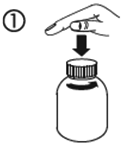
Follow these steps the first time you take Keppra®:
Take off the adaptor from the oral syringe (figure 2).
Put the adaptor into the top of the bottle (figure 3). Make sure it is fixed well in place. You do not need to remove the adaptor after use.
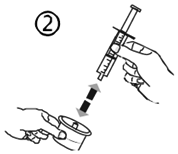
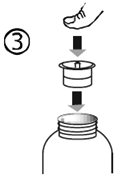
Follow these steps each time you take Keppra®:
Put the oral syringe into the adaptor opening (figure 4). Turn the bottle upside down (figure 5).
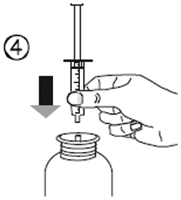
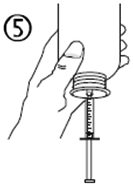
Hold the bottle upside down in one hand and use the other hand to fill the oral syringe.
Pull the plunger down to fill the oral syringe with a small amount of solution (figure 5A). Then push the plunger up to remove any possible air bubbles (figure 5B). Pull the plunger down to the millilitre (ml) dose marker on the oral syringe prescribed by your doctor (figure 5C).
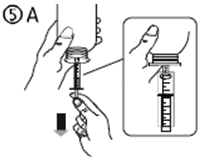


Turn the bottle the right way up (figure 6A). Remove the syringe from the adaptor (figure 6B).
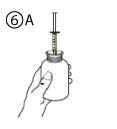
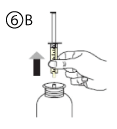
Empty the contents of the syringe in a glass of water or baby's bottle by pushing the plunger to the bottom of the syringe (figure 7).
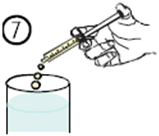
Drink the whole contents of the glass/baby's bottle.
Close the bottle with the plastic screw cap (you do not need to remove the adaptor).
To clean the syringe, rinse with cold water only, moving the plunger several times up and down to take up and expel the water, without separating the two components. figure 8).
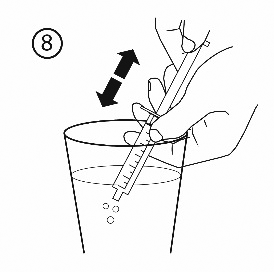
Keep the bottle, the oral syringe and the leaflet in the carton.
If you forget to use Keppra®
Keppra® should be used regularly at the same time each day.
Contact your doctor if you have missed one or more doses.
Do not take a double dose to make up for the dose that you missed. This may increase the chance of you getting an unwanted side effect.
If you use too much Keppra®
If you think that you have used too much Keppra®, you may need urgent medical attention.
You should immediately:
- phone the Poisons Information Centre
(by calling 13 11 26), or - contact your doctor, or
- go to the Emergency Department at your nearest hospital.
Symptoms of an overdose may include feeling drowsy.
You should do this even if there are no signs of discomfort or poisoning.
5. What should I know while using Keppra®?
Things you should do
Call your doctor straight away if you:
- If you notice an increase in seizures.
- If you have thoughts of harming yourself and/or symptoms of mood changes such as depression, nervousness, aggression, anger, anxiety, confusion, hallucination, irritability.
Remind any doctor, dentist or pharmacist you visit that you are using Keppra® and or before you have any surgery or emergency treatment.
Tell your doctor if you feel Keppra® is not helping your condition. Your doctor may need to change your medicine.
If you are pregnant while taking this medicine.
Things you should not do
- Stop taking Keppra®, or change the dosage, without checking with your doctor. Do not let yourself run out of medicine over the weekend or on holidays. Stopping Keppra® suddenly may cause unwanted side effects or make your condition worse. Your doctor will slowly reduce your dose before you can stop taking it completely.
- Give Keppra® to anyone else, even if their symptoms seem similar to yours or they have the same condition as you.
- Give this medicine to anyone with a fructose intolerance. It may cause a serious side effect.
- Take Keppra® to treat any other complaints unless your doctor tells you to.
Driving or using machines
Be careful before you drive or use any machines or tools until you know how Keppra® affects you.
As with other antiepileptic medicines, Keppra® may cause dizziness or drowsiness in some people. This is more frequent at the beginning of treatment or after an increase in the dose.
If you are feeling dizzy or drowsy do not drive, operate machinery, or do anything else that could be dangerous. Children should not ride a bike, climb trees or do anything else that could be dangerous if they are feeling dizzy or drowsy.
Drinking alcohol
Tell your doctor if you drink alcohol.
Alcohol combined with taking Keppra® may make you drowsy. Your doctor may suggest you avoid alcohol while you are being treated with Keppra®.
Looking after your medicine
- Keep Keppra oral solution in its original bottle until it is time to take it. If you take the solution out of the bottle it may not keep well.
- Keep your oral solution in a cool place where the temperature stays below 25°C and protect from light.
- After opening the bottle, the oral solution must be used within 7 months. You should write the date of opening the bottle on the bottle label, and the discard date.
Follow the instructions in the carton on how to take care of your medicine properly.
Store it in a cool dry place away from moisture, heat or sunlight; for example, do not store it:
- in the bathroom or near a sink, or
- in the car or on windowsills.
Keep it where young children cannot reach it.
When to discard your medicine
If your doctor tells you to stop taking this medicine or the expiry date has passed. Expiry is 7 months from the date of first use.
Getting rid of any unwanted medicine
If you no longer need to use this medicine or it is out of date, take it to any pharmacy for safe disposal.
Do not use this medicine after the expiry date.
6. Are there any side effects?
All medicines can have side effects. If you do experience any side effects, most of them are minor and temporary. However, some side effects may need medical attention.
See the information below and, if you need to, ask your doctor or pharmacist if you have any further questions about side effects.
Less serious side effects
| Less serious side effects | What to do |
Nervous system related:
| Speak to your doctor if you have any of these less serious side effects and they worry you. |
Serious side effects
| Serious side effects | What to do |
Mood related:
| Call your doctor straight away or go straight to the Emergency Department at your nearest hospital if you notice any of these serious side effects. |
Tell your doctor or pharmacist if you notice anything else that may be making you feel unwell.
Other side effects not listed here may occur in some people.
Reporting side effects
After you have received medical advice for any side effects you experience, you can report side effects to the Therapeutic Goods Administration online at www.tga.gov.au/reporting-problems. By reporting side effects, you can help provide more information on the safety of this medicine.
Always make sure you speak to your doctor or pharmacist before you decide to stop taking any of your medicines.
7. Product details
This medicine is only available with a doctor's prescription.
What Keppra® contains
| Active ingredient (main ingredient) | Levetiracetam |
| Other ingredients (inactive ingredients) |
|
| Potential allergens | 9g of maltitol is present per recommended maximum daily dose (30 mL) of Keppra®. Product containing maltitol may have a laxative effect or cause diarrhoea. Contains hydroxybenzoates and glycerol. |
Do not take this medicine if you are allergic to any of these ingredients.
What Keppra® looks like
Keppra® oral solution is available in a 100 mg/mL strength and is supplied in an amber bottle with a child resistant cap. It is also supplied with a measuring syringe for dosing and an adaptor for the syringe. (Aust R 120499).
Who distributes Keppra®
UCB Pharma
A division of UCB Australia Pty Ltd
Level 1, 1155 Malvern Road
Malvern VIC 3144, Australia
This leaflet was prepared in December 2024
Keppra is a registered trademark of UCB Pharma, S.A.
Published by MIMS April 2025


 Then CLcr is adjusted for body surface area (BSA) as follows (see Equation 2):
Then CLcr is adjusted for body surface area (BSA) as follows (see Equation 2):
 For children with renal impairment, levetiracetam dose needs to be adjusted based on the renal function as levetiracetam clearance is related to renal function. This recommendation is based on a study in adult renally impaired patients.
For children with renal impairment, levetiracetam dose needs to be adjusted based on the renal function as levetiracetam clearance is related to renal function. This recommendation is based on a study in adult renally impaired patients. The relative risk for suicidal thoughts or behaviour was higher in clinical trials for epilepsy than in clinical trials for psychiatric or other conditions, but the absolute risk differences were similar for the epilepsy and psychiatric indications.
The relative risk for suicidal thoughts or behaviour was higher in clinical trials for epilepsy than in clinical trials for psychiatric or other conditions, but the absolute risk differences were similar for the epilepsy and psychiatric indications. In the pooled safety analysis, there was no clear dose response relationship but incidence and severity of CNS related undesirable effects decreased over time.
In the pooled safety analysis, there was no clear dose response relationship but incidence and severity of CNS related undesirable effects decreased over time. The incidence of serious adverse events in placebo controlled studies was 9.9% in the levetiracetam group versus 8.9% in the placebo group. Many of the serious adverse events are typical for a population of patients with epilepsy.
The incidence of serious adverse events in placebo controlled studies was 9.9% in the levetiracetam group versus 8.9% in the placebo group. Many of the serious adverse events are typical for a population of patients with epilepsy. Other events occurring in 2% or more of paediatric patients treated with Keppra but as or more frequent in the placebo group were the following: abdominal pain, allergic reaction, ataxia, convulsion, epistaxis, fever, headache, hyperkinesia, infection, insomnia, nausea, otitis media, rash, sinusitis, status epilepticus (not otherwise specified), thinking abnormal, tremor, and urinary incontinence.
Other events occurring in 2% or more of paediatric patients treated with Keppra but as or more frequent in the placebo group were the following: abdominal pain, allergic reaction, ataxia, convulsion, epistaxis, fever, headache, hyperkinesia, infection, insomnia, nausea, otitis media, rash, sinusitis, status epilepticus (not otherwise specified), thinking abnormal, tremor, and urinary incontinence. The percentage of patients (y-axis) who achieved ≥ 50% reduction in weekly seizure rates from baseline in partial onset seizure frequency over the entire randomised treatment period (titration + evaluation period) within the three treatment groups (x-axis) is presented in Figure 1.
The percentage of patients (y-axis) who achieved ≥ 50% reduction in weekly seizure rates from baseline in partial onset seizure frequency over the entire randomised treatment period (titration + evaluation period) within the three treatment groups (x-axis) is presented in Figure 1.
 The percentage of patients (y-axis) who achieved ≥ 50% reduction in weekly seizure rates from baseline in partial onset seizure frequency over the entire randomised treatment period (titration + evaluation period) within the three treatment groups (x-axis) is presented in Figure 2.
The percentage of patients (y-axis) who achieved ≥ 50% reduction in weekly seizure rates from baseline in partial onset seizure frequency over the entire randomised treatment period (titration + evaluation period) within the three treatment groups (x-axis) is presented in Figure 2. The comparison of Keppra 2000 mg/day to Keppra 1000 mg/day for responder rate was statistically significant (P = 0.02). Analysis of the trial as a crossover yielded similar results.
The comparison of Keppra 2000 mg/day to Keppra 1000 mg/day for responder rate was statistically significant (P = 0.02). Analysis of the trial as a crossover yielded similar results. The percentage of patients (y-axis) who achieved ≥ 50% reduction in weekly seizure rates from baseline in partial onset seizure frequency over the entire randomised treatment period (titration + evaluation period) within the two treatment groups (x-axis) is presented in Figure 3.
The percentage of patients (y-axis) who achieved ≥ 50% reduction in weekly seizure rates from baseline in partial onset seizure frequency over the entire randomised treatment period (titration + evaluation period) within the two treatment groups (x-axis) is presented in Figure 3.
 The percentage of patients (y-axis) who achieved ≥ 50% reduction in weekly seizure rates from baseline in partial onset seizure frequency over the entire randomised treatment period (titration + evaluation period) within the two treatment groups (x-axis) is presented in Figure 4.
The percentage of patients (y-axis) who achieved ≥ 50% reduction in weekly seizure rates from baseline in partial onset seizure frequency over the entire randomised treatment period (titration + evaluation period) within the two treatment groups (x-axis) is presented in Figure 4.

 The percentage of patients (y-axis) who achieved ≥ 50% reduction in weekly seizure rates from baseline in PGTC seizure frequency over the entire randomised treatment period (titration + evaluation period) within the two treatment groups (x-axis) is presented in Figure 5.
The percentage of patients (y-axis) who achieved ≥ 50% reduction in weekly seizure rates from baseline in PGTC seizure frequency over the entire randomised treatment period (titration + evaluation period) within the two treatment groups (x-axis) is presented in Figure 5. When Keppra was used to treat primary generalised tonic-clonic seizures in adults and adolescents with idiopathic generalised epilepsy, there was no effect on the frequency of absences.
When Keppra was used to treat primary generalised tonic-clonic seizures in adults and adolescents with idiopathic generalised epilepsy, there was no effect on the frequency of absences.
